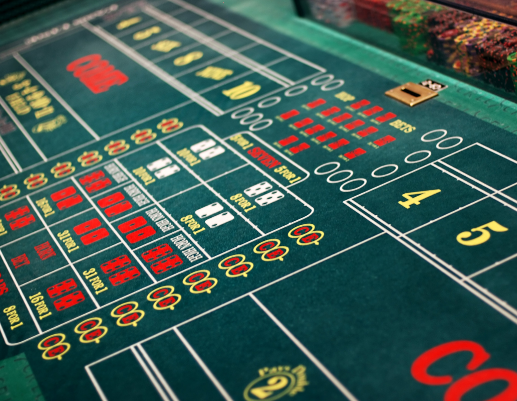History of craps
Although it is a popular choice in traditional and online casinos around the world today, craps is in fact an ancient game that dates back hundreds of years. Nevertheless, it did not exist in its current form until the early 1900s, when the way the game was played, the rules, and the dice became more standardized.
Some historians believe the first games that resembled what we now call craps were played by Roman soldiers in around 600 BC. They created a game that incorporated bleached pig knuckles, that would roll across the flat surface of their shields. Into each knuckle, they would carve a series of dots and once they were rolled, the soldiers would bet on the way each knuckle landed.
Every soldier carried his own knucklebones and as they were irregular in shape, the owners soon got to know how the bones would behave when rolled a certain way. That made it easier to cheat or maybe just to get a better idea of how the roll would play out, compared to using square dice. It is difficult to say how many of the early rules and how much the style of this game influenced what we now see as the modern game. However, people have suggested that the phrase ‘throwing the bones’ dates back to this point in craps history.
After its appearance in ancient Rome, the next significant mention of the game was during the 1100s in England. Sir William of Tyre is said to have created the game for himself and his knights to play during the Crusades. He named it after a castle that his troops were about to attack.
It works in much the same way as craps, with players taking turns to be the caster and throw the dice, while the other players bet on the results. Bets were placed on whether certain numbers were rolled, and others were avoided. Throughout the Middle Ages in England, the game evolved and became more popular and widespread. In fact, it was such an accepted part of the cultural landscape at this time, that Geoffrey Chaucer made frequent references to it in his 1392 volume of stories, The Canterbury Tales.
Just after this period, in the early 1600s, Hazard underwent a massive growth in popularity after reaching French shores. Played in cafes and saloons across the country, in one version of craps history it became affectionately known as Crabs around this time. Crabs was the nickname players gave to getting the worst roll of all, a two. The French appreciated a game that could be played casually, without the need for any equipment or a specific setting. As the only thing required was a pair of dice, people played crouched down in little huddles.
This led to the second possible origin of the game’s name, the word crapaud, because to the French, the squatting players looked just like toads, or crapaud in French. According to this history of craps, the slightly harsh nickname was eventually shortened to craps, and it has been the same ever since. Either way, by the time the first English casinos were established in the early 18th century, it was a pastime that even the nobility and royals often enjoyed.
Origins of craps
By the 1600s, craps had also traveled across the Atlantic with French settlers and arrived in Acadia, a French colony that was spread across some parts of modern Maine and Canada. It was played there extensively until the English took control of Acadia from the French in 1755, and quickly renamed this stunning area of the world Nova Scotia. A huge number of French nationals remained, but most chose to relocate to the south of the US, eventually settling in Louisiana and becoming known as the Louisiana Acadians or Cajuns. During their long trek through the developing United States, they brought and shared their history of craps.
The game was further popularized in the US by laborers working on the Mississippi River, and by now it was known locally as Crebs. Once the politician, playboy, gambler, and nobleman, Bernard de Marigny arrived in New Orleans in 1805, from London, he set to work developing a different version of the game. Knowing that it was seen as a likely outcome, his version of craps only required a seven to be rolled and that is what players had to aim for.
When he took his idea to the American middle classes and wealthier gamblers, they were not amused, and neither were the royal figures in power at the time. As a result, the ever adaptable de Marigny took his game to players on the streets, who were happy to adopt his simplified, more profitable version. This meant that as the game traveled up the Mississippi Delta it was taken from boat to boat by laborers, as well as being played in streets and bars.
Growth in America
By the time the first American casinos were licensed to run in 1815, craps was widely available, but there was still plenty of controversy surrounding the game. Its varied history meant that different players had different versions of the game and expected certain rules to be in place, whereas many casinos used rigged dice to ensure their house edge. The person who changed all of this, and who largely standardized the game, was John H. Winn, a man who is often known as the ‘father of modern craps’.
To tackle the problem of different sections of the community having their own rules for a hugely popular game, he set about devising his own rules for craps in 1907. A dice maker by trade, Winn designed a layout for an official craps table and introduced several new elements. One of his ideas was the ‘don’t pass’ bet, which allows other players to wager against the shooter, a concept that was never before considered in the history of craps.
His expanded rules ensured that gameplay was more consistent and there were fewer disagreements at the table. As a result, casinos could simply set payouts and guarantee their house edge, so Winn’s suggestions took root in houses across the US. There was no longer any point in the casino rigging their dice, and the idea of craps being a disorganized, confusing game began to fade.
Further into the 20th century, American soldiers carried their love for the game around the globe during World War II. At this point in the history of craps, it gained popularity with a much more diverse range of people. Soon, all the biggest and brightest casinos in the south of France, the Caribbean, and Las Vegas were opening up craps tables. By the 1960s, more of Europe, as well as Asia and Australia followed their lead.
Craps today
Today and throughout its history, craps is considered one of the most lively and fun games at the casino. It is a very hands-on game and that makes it different from many casino titles, in which players are not allowed to touch the casino’s equipment. In craps, there is no croupier to control the action from the other side of the table, because it will always be the players who throw the dice. If they get a great result on their opening roll, the entire table will be cheering, which for many is one of the most exhilarating experiences at the casino.
People are very vocal around a craps table, and they congratulate or thank each other for rolls throughout a session. While many feel that throwing the dice is an essential part of the experience, not everyone wants to, and the choice to do so or not is down to the individual player. Some people will always prefer to stay out of the spotlight, but that is fine as well, because this is a game with plenty to see.
It is also a great game to play with friends because as soon as someone has a terrible roll, they can be sure their friends will be there to remind them the next time! Unlike other casino games where everyone sits in silence and carefully contemplates the play, at a craps table there is constant banter and chatter, as well as a stick man who controls the pace of the game for the casino. Again, even the stick man tends to get in with the celebratory air of craps, as this person will often use specialized slang to call the numbers and build the atmosphere.
The game uses two dice and is played on a table, each player uses chips to place their bets, just like in many other casino games. They are wagering on how the dice will land, once the shooter has rolled them. Specifically, what the value of the roll will be. At any one time, there can be up to 20 people around the table and the game is made up of rounds. That means everyone can take a turn at being the shooter if they want to roll the dice.
Online and offline, the game is played in much the same way. It starts with what is known as a ‘pass line’ bet. Players bet a dice will land on a seven or an 11, a ‘pass the line’, a two, three, or a 12 — also known as ‘don’t pass’. Next, the dice are rolled and everyone checks their bets when they land. Winning bets are cashed out immediately, but less successful wagers simply stay in play for the following rolls.
Any other number, the four, five, six, eight, nine, and 10, which the dice land on after the first roll, are set up as the ‘point’. Then the action continues until either a seven or a point number is rolled. Once the point is set, more bets can be placed and the shooter keeps rolling. Should the point roll before the seven, all bets on the pass line are winners. If it rolls after the seven, it is the don’t pass bets that make a profit.
There are the standard, basic rules, but many players choose to enrich their experience at the table by researching all the possible bets and payouts.
Online casino craps
Online craps follows many of the same rules as traditional casino craps, but instead of having to go out to play, people can log on for a few games at home. Players choose this option because it is so convenient and means that even if they want to hang out in their pajamas on the couch, they can still enjoy some top-class craps action because the casino is only a few clicks away.
Online casino craps also appeals to people who are just starting with the game. Often, this is because there are so many bets in the game and they do not yet understand exactly how it works. In an online environment, it is easier to learn at a pace that suits the individual, people can take their time, observe the action, and even take notes if they want to remember certain points for the next game. That is very different from the experience of playing at a live casino, where there can be added pressure from other, more experienced players around the table.
Players can also brush up on their craps skills during an online tutorial. Many online casinos provide these to take newcomers through the different stages of a game in a step-by-step way, so they can get a feel for how the game works and gain confidence before placing a bet. Although craps is a game of chance and there is never a guarantee of winning, there are ways to maximize the time spent at a craps table. Taking time to research all the available bets, learning more about the house edge, and understanding payouts can help a player’s budget go further.




